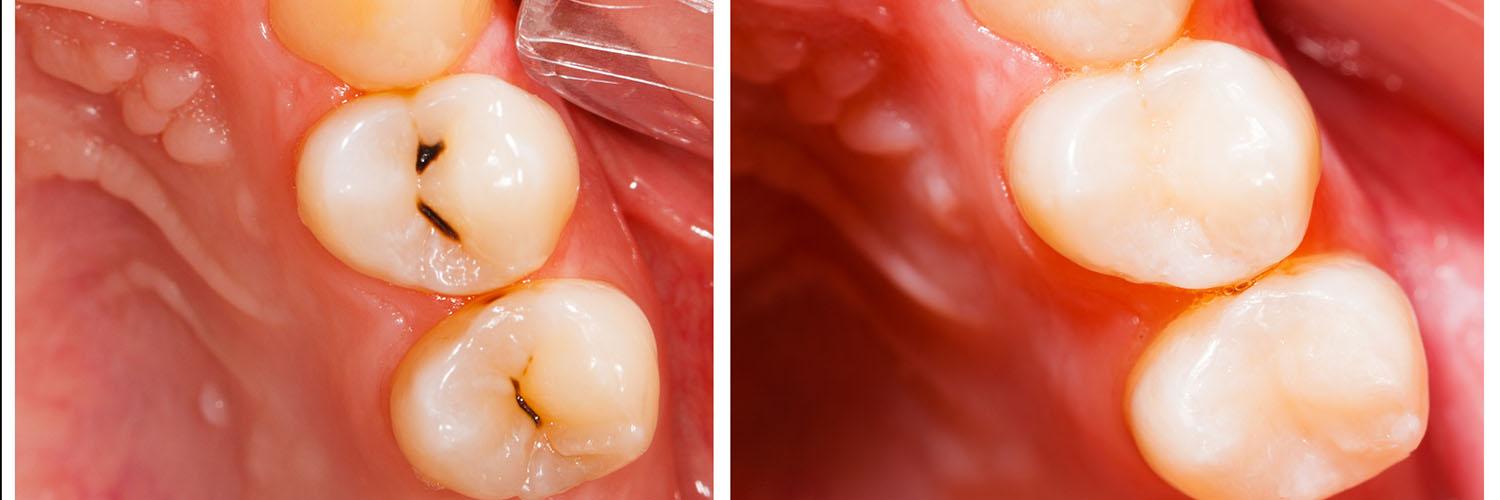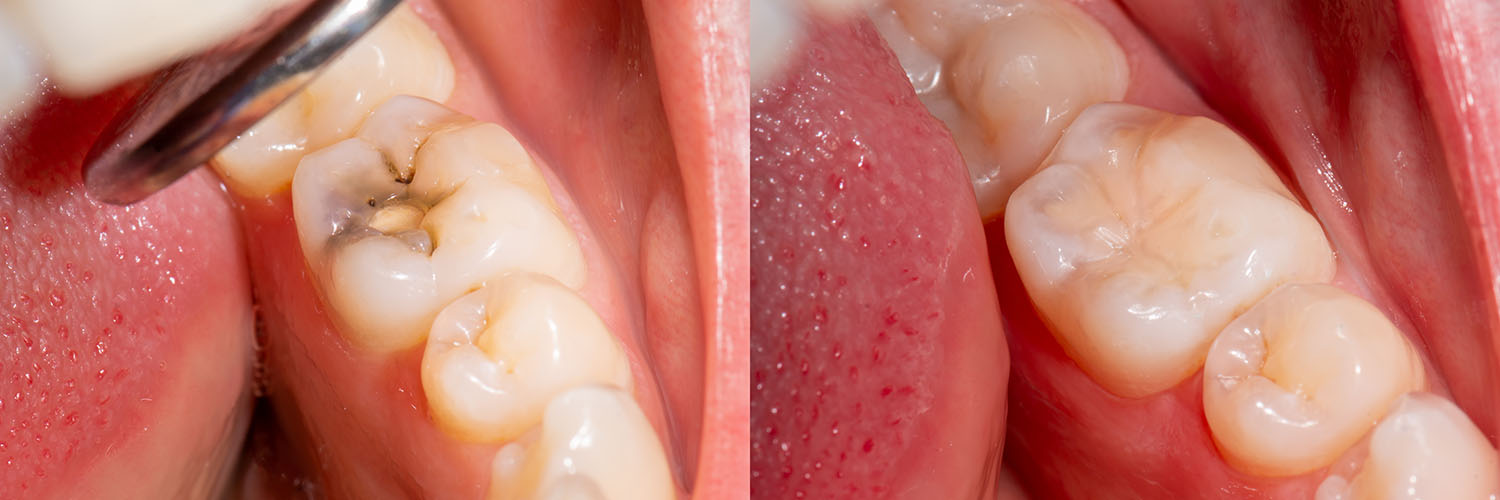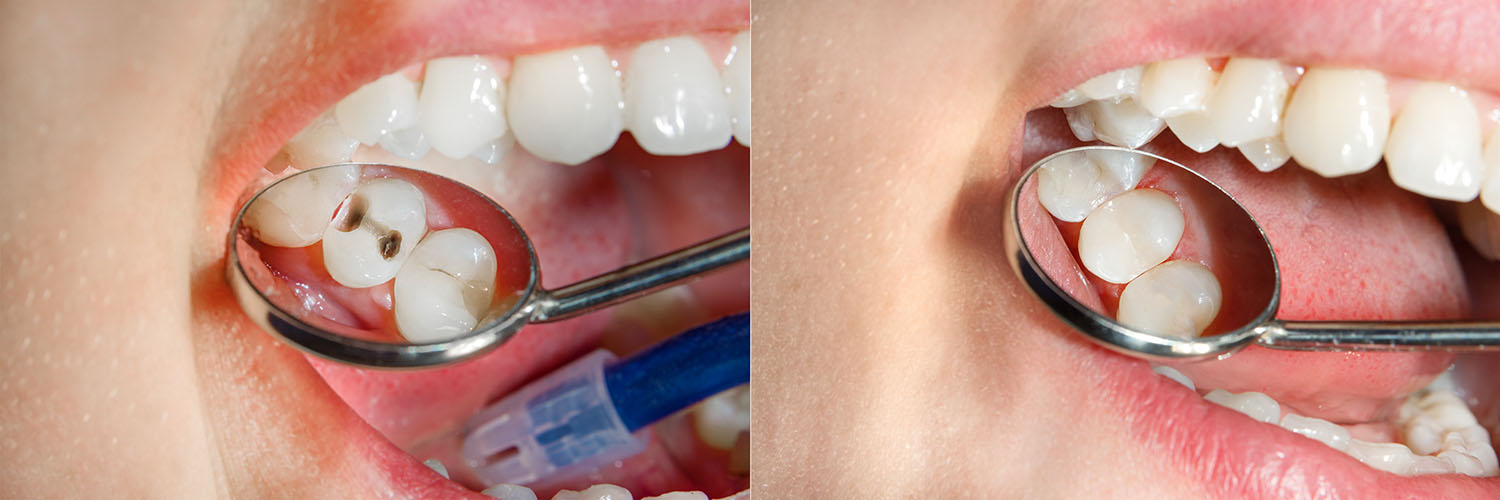
When decay or damage removes healthy tooth structure, a dental filling rebuilds the tooth so it can chew, speak, and look like itself again. Fillings restore the tooth's contour and protect the inner layers from bacteria and sensitivity, allowing the mouth to function normally without compromising adjacent teeth.
Because cavities remain one of the most common oral health conditions across all ages, placing and repairing fillings is a routine but essential part of general dentistry. The goal is not only to stop decay but to preserve as much of the natural tooth as possible while delivering a restoration that performs reliably over time.
At the office of Fay Hu General Dentistry, we approach fillings with a balance of precision and patient-centered care. We focus on minimally invasive techniques and materials chosen to match your needs—whether that means prioritizing durability in a back tooth or achieving a seamless aesthetic for a visible front tooth.
People have attempted to mend broken and decayed teeth for millennia, with archaeological evidence showing primitive fillings in some of the earliest human remains. Through the centuries, materials and methods evolved—from early metal foils and alloys to the widespread use of amalgam in the 19th and 20th centuries.
More recent advances in dental science have expanded restorative choices. Modern composite resins, glass ionomers, ceramics, and laboratory-fabricated inlays/onlays allow dentists to match the color, shape, and wear characteristics of natural teeth while avoiding metals when desired.
These improvements give patients a combination of aesthetics and performance that was not always possible in the past, allowing restorations that are discreet, long-lasting, and kinder to surrounding tooth structure.
Every restoration begins with a clear diagnosis. We evaluate cavity size, tooth position, bite forces, and cosmetic expectations to determine the best material and technique. Small restorations often need only a direct filling placed in a single visit, while larger defects may benefit from an indirect solution such as an onlay or ceramic inlay.
Conservation of healthy tooth structure guides our treatment philosophy. When possible, we use adhesive techniques that bond restorations to remaining enamel and dentin, reinforcing the tooth rather than removing extra material for retention.
We’ll discuss the pros and cons of each option during your visit, explaining how a chosen material will perform in your mouth and what you can expect in terms of longevity and care. The treatment plan prioritizes both oral health and how your smile looks and feels.

Today’s restorative materials vary in composition, handling, and appearance. Some are placed directly in the mouth and harden there; others are crafted in a lab and bonded into place. The choice depends on the tooth's location, the extent of decay, aesthetic priorities, and functional demands.
For many patients, the decision balances appearance with durability: anterior teeth often call for tooth-colored solutions, while posterior teeth may require materials that resist heavy chewing forces. Understanding the strengths and limitations of each material helps set realistic expectations.
Below is an overview of common filling types and how they are typically used in modern dentistry.
Composite resins are made of a resin matrix reinforced with glass or ceramic particles. They are available in many shades, allowing a close match to your natural teeth. Because composites bond directly to tooth structure, they can often be placed with minimal removal of healthy enamel or dentin.
Composites are versatile: they repair small cavities, reshape worn or chipped teeth, and serve as cosmetic bonding in the front of the mouth. While they provide excellent aesthetics, they can be more prone to wear or staining over many years and may need maintenance in some cases.
Amalgam has a long track record for strength and longevity, particularly in large restorations on chewing surfaces. Though not tooth-colored, amalgam can be the best choice when durability under heavy bite forces is the primary concern.
Amalgam remains a reliable option for certain situations, especially where access or moisture control makes placement of adhesive materials more challenging.
Glass ionomer materials bond chemically to tooth structure and release fluoride over time, which can help protect the tooth from recurrent decay. They are often used in areas where esthetics and moderate strength are acceptable, and they are commonly chosen for pediatric restorations and for cavities near the gum line.
Because glass ionomers are less wear-resistant than some alternatives, they are sometimes used as a long-term temporary or in low-stress locations.
Ceramic restorations are fabricated outside the mouth from porcelain or other dental ceramics. They are extremely resistant to staining and wear, providing a highly aesthetic and durable solution for larger defects where a simple direct filling would not offer sufficient strength.
Ceramic inlays and onlays are bonded into place and can preserve more natural tooth structure compared with a full crown, making them an excellent option for many posterior teeth with significant but not catastrophic damage.
Gold remains a premium restorative material prized for its biocompatibility and remarkable longevity. While less commonly selected for cosmetic reasons, gold onlays and inlays offer exceptional fit and wear resistance for patients who prefer or require the highest durability.
Because of its stability and strength, gold can be an excellent long-term solution in select clinical situations.

Treatment starts with a careful exam. We use clinical inspection, magnification, and diagnostic imaging when appropriate to detect decay and assess how far it has progressed. Early detection often means simpler, more conservative treatment.
If a cavity is present, the affected tooth is prepared by removing decayed tissue and shaping the remaining tooth so the restoration will seal and function correctly. The preparation varies with material choice: bonded composites often require less removal than traditional restorations.
Most routine fillings are completed in a single visit under local anesthesia, ensuring the procedure is comfortable. For larger defects or when an indirect restoration is indicated, we'll take impressions or digital scans and schedule a follow-up appointment to place the finished restoration.
Throughout treatment we prioritize your comfort and explain each step so you know what to expect. For patients who experience dental anxiety, options to make the visit more relaxed are available and can be discussed during your consultation.
Following placement, a restored tooth may feel different for a short time as oral tissues adapt and any local anesthetic wears off. Mild sensitivity to hot or cold is common but usually resolves within days to weeks. If sensitivity increases or chewing causes discomfort, contact the office for an evaluation.
Until numbness returns to normal, avoid biting or chewing on the treated side to prevent accidental injury. Once normal sensation returns, gradual resumption of regular eating is fine unless otherwise advised by your dentist.
Good oral hygiene—brushing twice daily, flossing, and routine dental exams—helps maximize the life of any restoration. Regular checkups allow your dentist to monitor fillings for wear, detect new decay early, and make adjustments as needed to your bite or polish a restoration for comfort.
When a restoration reaches the end of its serviceable life or if the tooth sustains a new injury, there are well-established repair and replacement options that preserve function and appearance while protecting your oral health.
For questions about which filling material is best for your situation or to schedule an evaluation, please contact us. Our team is happy to explain your options and help you choose a plan that supports a healthy, lasting smile.


If the pleasure of eating a delicious bowl of ice cream or sipping a soothing cup of tea gets overshadowed by dental pain that makes you wince; it's time to contact our office. As skilled providers of care, we'll determine what's causing your discomfort and perform the treatment required to alleviate your symptoms and get you back on the road to oral health.
Cavities develop because of an infectious process that causes progressive damage to tooth structure. Despite starting as a pinpoint defect on the outermost enamel layer of your tooth, untreated dental decay progressively compromises more and more healthy tooth structure as it works its way to the inner layers of your tooth.
Yes, you can still develop tooth decay on other surfaces of the tooth, around the margins of an old filling, or in fewer instances, recurrent decay underneath it. For this reason, it's essential to maintain excellent oral hygiene, a diet low in sugary beverages and sweets, and be sure to visit our office for routine checkups and care. While tooth decay is second only to the common cold in frequency, it's almost entirely preventable.
We value the time and comfort of our patients. If cavities are located on adjacent teeth, or in the same section of your smile, it may be possible to treat more than one tooth during your visit. However, how much is done each visit depends on several factors. We keep our patients well informed and tailor every treatment plan and visit to address their unique needs.
Addressing concerns on the presence of elemental mercury in silver fillings, the American Dental Association (ADA), The Center for Disease Control and Prevention (CDC), the FDA, and the World Health Organization have all stated that amalgam restorations do not pose a risk to health. However, individuals with allergies or sensitivities to the metals in dental amalgam are advised to pursue other restorative options.
Dental fillings are performed under local anesthesia to help ensure your comfort throughout the entire procedure. The involved tooth remains completely numb for the extent of your visit. Within one or two hours after the procedure is completed, the local anesthetic will gradually wear off, and normal sensations return.
A tooth-colored composite filling is fully hardened and set by the end of your visit. However, we may advise you to wait a couple of hours until the local anesthesia has completely worn off. This advice is to help ensure you don't accidentally bite your lip, cheek, or tongue while still numb.
The lifetime of a dental filling varies depending on the type of material used. While popular dental materials can last a decade or more with proper care, they can degrade over time, wear down, or even break. When this happens, you may experience some tooth sensitivity, a jagged edge, or a loose or dislodged piece of filling material. Whatever the case may be, it's essential to get the filling replaced before the tooth sustains further damage or other consequences arise. Beyond taking good care of your smile to help ensure the longevity of your fillings, our office regularly checks the status of your existing fillings as part of a routine checkup exam.
Dental fillings are an essential investment that serves to preserve and protect the health of your smile. With that said, how much a filling costs depends on the number of surfaces of the tooth involved and the filling material that is used. Amalgam restorations are the most economical. While tooth-colored composite fillings have a slightly higher cost, they offer the added benefits of being metal-free and much more aesthetically pleasing. Ceramic fillings, inlays, and onlays are more expensive than the preceding options but provide outstanding, long-lasting, and natural-looking results.
Dental insurances typically cover the cost of dental fillings. While we work with you to maximize your insurance benefits, there may still be an out-of-pocket expense. At the office of Fay Hu General Dentistry, we strive to help you begin care without any additional financial stress or delay.
Dental fillings are restorative materials used to repair a tooth damaged by decay or minor fracture. By removing decay and rebuilding the tooth's natural form, a filling restores strength, chewing function, and helps prevent further breakdown. Fillings can often be placed in a single visit and allow patients to keep more of their natural tooth compared with more extensive restorations.
Dentists select filling materials to balance durability, biocompatibility, and appearance while preserving as much healthy structure as possible. Advances in materials have expanded options beyond traditional metal restorations to include tooth-colored and indirect ceramic solutions. At the office of Fay Hu General Dentistry, care is tailored to each patient's needs to deliver durable, natural-looking results.
Several types of filling materials are commonly used today, each with distinct advantages and limitations. Composite resin, glass ionomer, ceramic (porcelain), gold, and dental amalgam are typical choices depending on clinical needs. Composite resins provide tooth-colored results while amalgam and gold have long histories of durability and wear resistance.
Glass ionomer cements bond to tooth structure and release fluoride, making them useful near the gum line or in pediatric dentistry. Indirect ceramic inlays and onlays are fabricated outside the mouth and offer excellent longevity and stain resistance for larger restorations. Your dentist will review the properties of each material and explain why one is recommended for your situation.
Selection depends on several factors including the size and location of the cavity, the amount of remaining tooth structure, and functional demands. Posterior teeth that endure heavy chewing forces may require more wear-resistant materials, while front teeth often benefit from highly aesthetic, tooth-colored materials. Patient-specific considerations such as oral hygiene, bruxism, and any known material sensitivities are also taken into account.
The dentist will also consider whether a direct filling placed immediately is appropriate or if an indirect solution such as an inlay, onlay, or crown is a better long-term choice. Diagnostic tools like digital x-rays and intraoral exams help determine the extent of decay and guide material selection. A clear explanation of options and expected outcomes is provided so patients can make informed decisions about their care.
A typical filling appointment begins with a clinical evaluation and any necessary radiographs to assess decay and tooth structure. Local anesthesia is administered so the area is numb before the dentist removes decay and prepares the cavity using rotary instruments, air abrasion, or laser tools. The prepared tooth is cleaned, and the chosen filling material is carefully placed, shaped, and polished to restore function and occlusion.
Direct fillings such as composites are placed and cured in the same visit, while indirect restorations like ceramic inlays may require a lab fabrication step and a follow-up appointment for cementation. Throughout the procedure the dentist checks your bite and makes any necessary adjustments to ensure comfort and proper function. Most routine fillings can be completed in about an hour, though extensive restorations may take longer or require staged visits.
Most patients experience little to no pain during filling placement because local anesthesia effectively numbs the treatment area. You may feel pressure or vibration from the instruments, but the anesthetized tooth should not be painful during the procedure. For patients with dental anxiety, the practice can discuss options to improve comfort, including behavioral techniques and sedation when appropriate.
At Fay Hu General Dentistry the care team takes time to explain each step and address concerns so patients feel more relaxed before treatment. After the anesthetic wears off some short-term sensitivity or mild aching is common and typically resolves within days with conservative care. If you experience persistent or worsening pain after a filling, contact the office promptly for evaluation and management.
Immediately after a filling you may notice numbness that can last an hour or two, so avoid chewing or manipulating the area until normal sensation returns. It is also common to have transient sensitivity to hot, cold, or pressure that diminishes over several days as the tooth settles. Good oral hygiene, including brushing with a fluoride toothpaste and daily flossing, helps protect the restored tooth and reduce the risk of future decay.
Avoid very hard or sticky foods for the first 24 hours if you had a large restoration, and follow any specific postoperative instructions provided by your dentist. Regular dental exams and professional cleanings allow your provider to monitor the condition of fillings and detect wear, marginal breakdown, or recurrent decay early. If you notice a rough edge, a change in your bite, or prolonged sensitivity, schedule an evaluation to confirm the restoration is functioning properly.
There is no single lifespan for fillings; longevity depends on the material, location in the mouth, chewing forces, and personal oral hygiene habits. Composite and glass ionomer fillings may show wear or staining sooner than ceramic or gold restorations, while amalgam and gold have historically provided long service life. Biting forces from bruxism, frequent acidic diets, or poor oral hygiene can shorten a filling's useful life irrespective of the material chosen.
Routine dental exams and periodic x-rays help detect early signs that a filling may need repair or replacement, such as recurrent decay, cracks, or leakage at the margins. When a restoration fails, the dentist will recommend the appropriate next step, which could include replacing the filling, placing an inlay or onlay, or recommending a crown if the damage is extensive. Maintaining preventive care and addressing dental issues promptly helps extend the service life of restorations.
Treating cavities in primary (baby) teeth requires a balance between preserving function and using materials suited to the expected lifespan of the tooth. Glass ionomer restorations are often favored for their fluoride release and bonding properties in small crowns or cavities near the gumline. Behavior guidance techniques, parental involvement, and minimally invasive approaches help make care more comfortable and effective for young patients.
When decay is extensive or a tooth is at high risk of failure, the dentist may recommend more durable solutions or refer to a pediatric specialist for advanced treatment. Early repair of cavities in primary teeth helps prevent pain, infection, and premature tooth loss, which can affect speech and the development of permanent teeth. Routine preventive visits, sealants, and fluoride therapies are important components of pediatric dental care to reduce the need for restorative work.
When a cavity compromises most of the tooth structure, a direct filling may not provide adequate strength or longevity and an indirect restoration is often recommended. Inlays and onlays are laboratory-fabricated restorations that conserve tooth structure while providing superior wear resistance compared with large direct fillings. A crown covers and protects a significantly weakened tooth, restoring function and preventing further fracture or decay progression.
If decay has reached the dental pulp, endodontic therapy (root canal) combined with a crown may be necessary to save the tooth, whereas extraction is considered when a tooth cannot be restored. Your dentist will discuss the relative benefits of each option and recommend the treatment that offers the best long-term prognosis for the tooth. Selecting an appropriate restorative path aims to preserve oral health and maintain comfortable, predictable function.
Most fillings are placed without issue, but complications can include sensitivity, marginal staining, fracture of the restoration, or recurrent decay at the edges. Short-term sensitivity is common and usually resolves on its own, while persistent pain or swelling requires prompt evaluation. Dentists monitor restorations during routine visits and can repair or replace compromised fillings to prevent more serious problems.
If a filling cracks or a new area of decay develops, early intervention can often preserve the tooth and avoid more invasive procedures. The dental team will use clinical exam findings and radiographs to determine the cause of the problem and recommend appropriate treatment. Contact your dental office if you notice a loose filling, a change in bite, or any persistent discomfort so an assessment can be scheduled.

We are dedicated to providing the highest quality of dental care to our patients.
Through excellence in dentistry and quality in relationships, we strive to positively impact your oral health, aesthetics, and self-esteem. From the front desk to the treatment room, our experienced team is here to support you with expert care and genuine compassion.